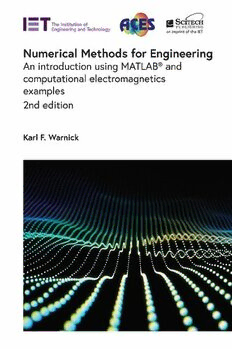
Numerical Methods for Engineering: An introduction using MATLAB® and computational electromagnetics examples (Electromagnetic Waves) PDF
Preview Numerical Methods for Engineering: An introduction using MATLAB® and computational electromagnetics examples (Electromagnetic Waves)
Numerical Methods for Engineering The ACES Series on Computational and Numerical Modelling in Electrical Engineering AndrewF.Peterson,PhD–SeriesEditor Thevolumesinthisseriesencompassthedevelopmentandapplicationofnumerical techniques to electrical and electronic systems, including the modelling of electro- magnetic phenomena over all frequency ranges and closely related techniques for acoustic and optical analysis. The scope includes the use of computation for engi- neeringdesignandoptimization,aswellastheapplicationofcommercialmodelling toolstopracticalproblems.Theserieswillincludetitlesforseniorundergraduateand postgraduateeducation,researchmonographsforreference,andpractitionerguides andhandbooks. PublishedBooksintheACESSeries: W.Yu, X.Yang, and W. Li, “VALU, AVX and GPU Acceleration Techniques for ParallelFDTDMethods,”2014. A.Z. Elsherbeni, P. Nayeri, and C.J. Reddy, “Antenna Analysis and Design Using FEKOElectromagneticSimulationSoftware,”2014. A.Z. Elsherbeni and V. Demir, “The Finite-Difference Time-Domain Method in ElectromagneticswithMATLAB®Simulations,2ndEdition,”2015. M. Bakr, A.Z. Elsherbeni, and V. Demir, “Adjoint Sensitivity Analysis of High FrequencyStructureswithMATLAB®,”2017. O.Ergul,“NewTrendsinComputationalElectromagnetics,”2019. D.Werner,“NanoantennasandPlasmonics:Modelling,designandfabrication,”2020. Numerical Methods for Engineering An introduction using MATLAB® and computational electromagnetics examples 2nd Edition Karl F. Warnick TheInstitutionofEngineeringandTechnology PublishedbySciTechPublishing,animprintofTheInstitutionofEngineeringandTechnology, London,UnitedKingdom TheInstitutionofEngineeringandTechnologyisregisteredasaCharityinEngland&Wales (no.211014)andScotland(no.SC038698). ©TheInstitutionofEngineeringandTechnology2020 Firstpublished2011 SecondEditionpublished2020 ThispublicationiscopyrightundertheBerneConventionandtheUniversalCopyright Convention.Allrightsreserved.Apartfromanyfairdealingforthepurposesofresearch orprivatestudy,orcriticismorreview,aspermittedundertheCopyright,Designsand PatentsAct1988,thispublicationmaybereproduced,storedortransmitted,inany formorbyanymeans,onlywiththepriorpermissioninwritingofthepublishers,orin thecaseofreprographicreproductioninaccordancewiththetermsoflicencesissued bytheCopyrightLicensingAgency.Enquiriesconcerningreproductionoutsidethose termsshouldbesenttothepublisherattheundermentionedaddress: TheInstitutionofEngineeringandTechnology MichaelFaradayHouse SixHillsWay,Stevenage Herts,SG12AY,UnitedKingdom www.theiet.org Whiletheauthorandpublisherbelievethattheinformationandguidancegiveninthis workarecorrect,allpartiesmustrelyupontheirownskillandjudgementwhenmaking useofthem.Neithertheauthornorpublisherassumesanyliabilitytoanyoneforany lossordamagecausedbyanyerrororomissioninthework,whethersuchanerroror omissionistheresultofnegligenceoranyothercause.Anyandallsuchliability isdisclaimed. Themoralrightsoftheauthortobeidentifiedasauthorofthisworkhavebeen assertedbyhiminaccordancewiththeCopyright,DesignsandPatentsAct1988. BritishLibraryCataloguinginPublicationData AcataloguerecordforthisproductisavailablefromtheBritishLibrary ISBN978-1-83953-073-9(hardback) ISBN978-1-83953-074-6(PDF) TypesetinIndiabyMPSLimited PrintedintheUKbyCPIGroup(UK)Ltd,Croydon Contents AbouttheAuthor xiii Preface xv 1 Introduction 1 1.1 ScientificComputation,NumericalAnalysis,andEngineering 2 1.2 ComputationalElectromagnetics 3 1.2.1 ApplicationsofCEMTools 5 1.2.2 TypesofCEMMethods 5 1.2.3 MeshandGridGeneration 6 1.3 AccuracyandEfficiency 7 1.4 ProgramingLanguages 8 1.5 WritingandDebuggingNumericalCodes 8 References 10 2 FundamentalsofElectromagneticFieldTheory 11 2.1 ElectromagneticFieldandSourceQuantities 11 2.2 Maxwell’sEquations 12 2.2.1 ConstitutiveRelations 12 2.2.2 ImpressedandInducedCurrents 13 2.2.3 MagneticCurrents 13 2.3 CoordinateSystems 14 2.3.1 RectangularCoordinates 14 2.3.2 CylindricalCoordinates 15 2.3.3 SphericalCoordinates 16 2.4 Gradient,Curl,andDivergence 16 2.5 Laplacian 18 2.6 WavePropagation 18 2.7 ElectromagneticBoundaryConditions 19 2.8 Time-andFrequency-DomainRepresentations 20 2.9 PlaneWaves 21 2.9.1 WaveVector 22 2.9.2 PositionVector 22 2.9.3 PlaneWaveinVectorNotation 23 2.9.4 CharacteristicImpedance 24 2.10 Propagating,Standing,andEvanescentWaves 24 2.11 BesselFunctions 25 vi NumericalMethodsforEngineering 2.11.1 HankelFunctions 26 2.11.2 CylindricalWaves 27 2.12 PowerandEnergy 28 2.13 InitialValueProblemsandBoundaryValueProblems 29 2.13.1 Modes 30 2.13.2 1-D,2-D,and3-DBoundaryValueProblems 30 2.13.3 RadiationandScatteringProblems 33 2.13.4 InverseProblems 34 2.13.5 Green’sFunctionsandRadiationIntegrals 34 2.13.6 FormulatingandSolvingBoundaryValueProblems 35 2.13.7 TheEquivalencePrinciple 36 2.14 OtherTopics 37 Problems 38 References 38 3 BasicNumericalTasks 41 3.1 IntroductiontoMATLABPrograming 41 3.1.1 VectorsandArrays 42 3.1.2 WorkingwithPlots 43 3.1.3 Scripts 45 3.1.4 Functions 48 3.1.5 ArgumentsandStructureArrays 49 3.1.6 SpeedingUpMATLABCodes 49 3.1.7 OtherMATLABCommands 49 3.2 NumericalDifferentiation 50 3.2.1 CodeExample:CentralDifferenceRule 51 3.3 NumericalIntegration 52 3.3.1 CodeExample:MidpointIntegrationRule 53 3.4 Interpolation 54 3.5 CurveFitting 54 3.5.1 CodeExample:PolynomialFitting 56 3.6 Newton’sMethod 57 Problems 58 References 59 4 FiniteDifferenceMethods 61 4.1 BasicComponentsofFiniteDifferenceSolvers 61 4.1.1 Grid 62 4.1.2 Stencil 63 4.1.3 BoundaryConditions 63 4.1.4 Sources 65 4.1.5 SolutionMethod 65 4.2 WaveEquation:1-DFDTDMethod 66 4.2.1 1-DGrid 66 4.2.2 UpdateEquationforthe1-DWaveEquation 67 Contents vii 4.2.3 InitialCondition 67 4.2.4 BoundaryConditionsforthe1-DFDTDMethod 68 4.2.5 HardandSoftSources 69 4.2.6 SourceTurn-OnFunctions 70 4.2.7 CodeExample:1-DFDTDAlgorithm 71 4.2.8 Stability 75 4.2.9 Accuracy 77 4.3 Laplace’sEquation:2-DFiniteDifferenceMethod 80 4.3.1 Example:2-DFDMethodona4-by-4Grid 83 4.3.2 WaveguideModes 83 4.3.3 SpectrumoftheLaplacian 85 4.3.4 NumericalImplementation 87 4.3.5 2-DFDforTransmissionLineswithDielectricMaterials 87 4.4 2-DFiniteDifferenceTime-Domain(FDTD)Method 89 4.4.1 2-DEMProblems 89 4.4.2 YeeCelland2-DFDTDMethodforTMPolarizedFields 91 4.4.3 DielectricandConductiveMaterials 93 4.4.4 AnisotropicMaterials 94 4.4.5 StabilityCriterion 94 4.4.6 BoundaryConditionsforthe2-DFDTDMethod 95 4.4.7 Preprocessing 101 4.5 FDTDModelingforScatteringProblems 102 4.5.1 IncidentField 103 4.5.2 ScatteredField 104 4.5.3 ScatteredFieldFormulation 104 4.5.4 ScatteringAmplitudes,ScatteringWidth,and RadarCrossSection 106 4.5.5 BistaticandMonostaticScattering 107 4.6 PostprocessingtheFDTDSolution 108 4.6.1 Frequency-Domain(Phasor)Fields 108 4.6.2 NearFieldtoFarFieldTransformation 110 4.6.3 OtherTypesofPostprocessing 116 4.7 CodeVerification 118 4.7.1 ScatteringbyaCircularCylinder 118 4.8 3-DFDTDMethod 120 4.8.1 PECCavity 122 4.8.2 StabilityCriterion 123 4.9 Summary 123 Problems 124 References 128 5 NumericalIntegration 131 5.1 TypesofIntegrationRules 132 5.2 Newton–CotesQuadratureRules 133 5.2.1 ErrorAnalysisoftheMidpointRule 133 viii NumericalMethodsforEngineering 5.2.2 HigherOrderNewton–CotesRules 137 5.2.3 ExtendedNewton–CotesRules 138 5.2.4 RombergIntegration 140 5.3 GaussianQuadrature 140 5.3.1 OrthogonalPolynomialsandGaussianQuadrature 142 5.3.2 Gauss–LegendreQuadrature(w(x)=1) 145 5.4 NonclassicalGaussianQuadratureRules 146 5.4.1 LanczosAlgorithm 147 5.4.2 WeightsandNodes 149 5.5 Implementation 150 5.6 OtherMethodsforSingularIntegrands 150 5.6.1 SingularitySubtraction 151 5.6.2 TransformationRules 152 5.7 MultidimensionalIntegrals 154 5.7.1 MonteCarloIntegration 155 5.8 MATLAB’sBuilt-inNumericalIntegration Functions 156 Problems 157 References 159 6 IntegralEquationsandtheMethodofMoments 161 6.1 IntegralOperators 161 6.1.1 FirstandSecondKindIntegralEquations 162 6.1.2 SolvingIntegralEquationsNumerically 162 6.1.3 SmoothKernelsandOperatorConditioning 163 6.1.4 Singular Kernels and Conditioning for Non-Fredholm Operators 164 6.2 IntegralEquationsinElectromagnetics 164 6.2.1 ElectricFieldIntegralEquation,2-DTransverseMagnetic Polarization(TM-EFIE) 166 6.2.2 ElectricFieldIntegralEquation, 2-DTransverseElectric Polarization(TE-EFIE) 168 6.2.3 MagneticFieldIntegralEquation 169 6.2.4 CombinedFieldIntegralEquation 169 6.2.5 Thin-WireIntegralEquations 170 6.3 MethodofWeightedResiduals 173 6.3.1 BasisFunctions 175 6.3.2 MoMImplementation 176 6.3.3 MeshTypes 177 6.4 MethodofMomentsfortheTM-EFIE 178 6.4.1 1-DMeshGenerationforSimpleGeometries 178 6.4.2 PathIntegrals 178 6.4.3 TestingIntegration 179 6.4.4 SourceIntegration 180 6.4.5 IncidentField 181 6.4.6 PhysicalInterpretationoftheMethodofMoments 181 Contents ix 6.4.7 MeshElementDensity 182 6.4.8 MoMCodeOverview 183 6.4.9 1-DMeshGenerationforComplexGeometries 184 6.4.10 Postprocessing 187 6.4.11 ScatteringAmplitudes 187 6.4.12 MoMImplementation 190 6.5 AccuracyandEfficiencyoftheMethodofMoments 192 6.5.1 ComputationalCost 192 6.5.2 ErrorAnalysis 194 6.5.3 SourcesofError 196 6.6 DielectricStructures 204 6.6.1 2-DVolumeMethodofMoments 205 6.7 2.5-DimensionalMethods 207 6.8 3-DElectricFieldIntegralEquation 208 6.8.1 RooftopFunctions 209 6.8.2 Rao–Wilton–Glisson(RWG)Basis 209 6.8.3 MethodofMoments 212 Problems 215 References 218 7 SolvingLinearSystems 219 7.1 LinearSpacesandLinearOperators 219 7.1.1 LinearSpaces 220 7.1.2 NormsonLinearSpaces 221 7.1.3 LinearOperators 222 7.1.4 OperatorNorms 222 7.1.5 Range,NullSpace,andRank 223 7.1.6 OperatorInverseandAdjoint 223 7.1.7 ClassesofOperators 224 7.1.8 EigenvaluesandEigenvectors 226 7.1.9 FieldofValues 226 7.1.10 MatrixDecompositions 226 7.1.11 OtherMatrixFormulas 229 7.2 DirectandIterativeSolutionMethods 229 7.3 LU Decomposition 231 7.4 IterativeMethods 232 7.4.1 StationaryIterations 232 7.4.2 ImplementationofIterativeAlgorithms 235 7.5 KrylovSubspaceIterations 236 7.5.1 ConjugateGradientMethod 236 7.5.2 ResidualError 238 7.5.3 ConditionNumber 239 7.5.4 CGNEAlgorithm 240 7.5.5 OtherKrylovSubspaceMethods 240 7.5.6 ConvergenceofKrylovSubspaceIterations 241 7.5.7 Preconditioners 245
